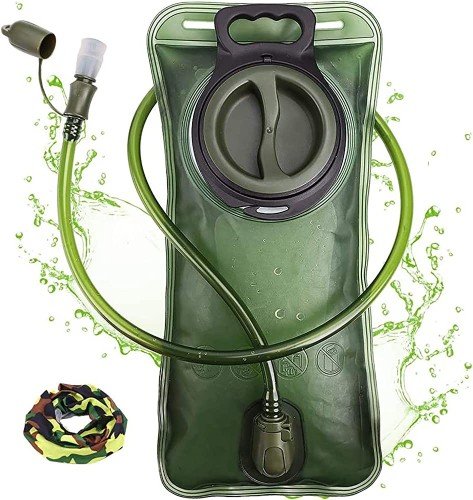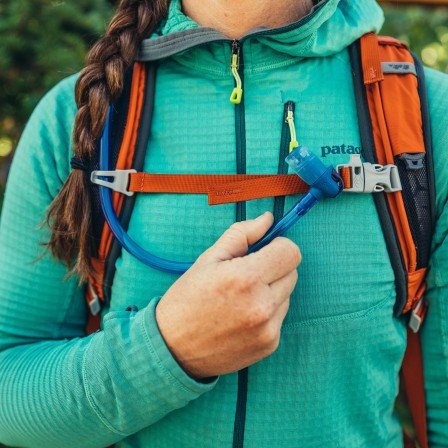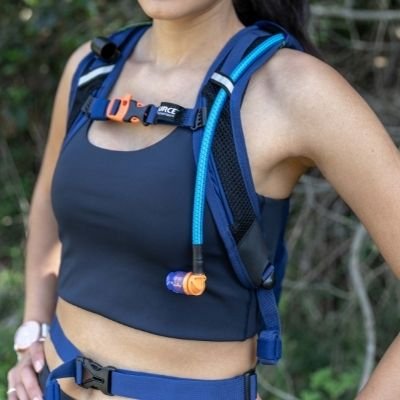
I. Introduction
As a supplier of hydration backpacks, we understand the challenges and concerns that arise when sourcing products for your business needs. In this blog, we aim to provide valuable insights and solutions to help you overcome these hurdles and make informed purchasing decisions.
Procuring hydration backpacks for your B2B business involves more than just selecting any available option. Factors such as leak-proof capabilities and user-friendliness are crucial in ensuring a seamless and satisfactory experience for your customers. We recognize the significance of these aspects and will delve into them from a meticulous perspective.
Our aim is to empower you with the knowledge and expertise needed to navigate the market confidently. We will share valuable tips, industry insights, and practical advice to help you find the perfect hydration backpacks that meet your customers’ needs and exceed their expectations.
II. Reservoir Design
A. Sealing mechanisms to prevent leaks
Sealing mechanisms play a critical role in preventing leaks and ensuring the integrity of hydration backpacks. The effectiveness of these mechanisms directly impacts the user experience and the overall performance of the backpack. Here are some key sealing mechanisms commonly employed to prevent leaks:
- Reservoir Closure System: A reliable reservoir closure system is essential for leak prevention. This can include features such as screw-on caps, flip-top lids, or slide-lock closures. These mechanisms create a tight seal between the reservoir and the backpack, preventing any water from escaping.
- O-Rings and Gaskets: O-rings and gaskets are often used in conjunction with closure systems to provide an extra layer of leak protection. These rubber or silicone seals ensure a watertight connection between different components of the hydration backpack, such as the reservoir and the hose or valve.
- Bite Valve Locks: Many hydration backpacks incorporate bite valves with locking mechanisms. These locks prevent accidental leakage when the valve is not in use. By securely closing off the flow of water, bite valve locks offer peace of mind during transportation or storage.
- Quick-Disconnect Couplings: Some hydration backpacks feature quick-disconnect couplings in the hose system. These couplings allow for easy detachment and reattachment of the hose without causing leaks. The couplings typically have internal shut-off valves that prevent water from escaping when disconnected.
- Self-Sealing Valves: Self-sealing valves are designed to automatically close when not in use, effectively preventing leaks. These valves are commonly found in bite valves or push-pull valves. They provide a reliable seal that stops water flow once the user releases pressure or stops drinking.
- Welded Seams and Reinforcements: In addition to sealing mechanisms, the construction of the hydration backpack itself plays a vital role in leak prevention. Welded seams and reinforcements at critical points, such as reservoir seams and hose connections, enhance the overall integrity of the backpack and minimize the risk of leakage.

B. Durable and puncture-resistant reservoir materials
Not only do these materials determine the backpack’s durability, but they also affect its puncture resistance. It’s important to select materials that are robust and puncture-resistant to ensure that the hydration pack remains functional and reliable even under challenging conditions.
There are a variety of materials available for hydration reservoirs, but some stand out for their exceptional durability and puncture resistance. Thermoplastic Polyurethane (TPU), for example, is a popular choice due to its ruggedness and ability to withstand rough handling, accidental impacts, and external pressures without losing its structural integrity. Polyethylene Vinyl Acetate (PEVA) and Polyvinyl Chloride (PVC) are other materials commonly used for hydration reservoirs. They offer good durability and excellent puncture resistance, making them suitable for outdoor activities such as hiking, cycling, and running. Finally, some hydration backpacks take durability and puncture resistance to the next level by utilizing multi-layered films. These films combine a variety of materials, such as TPU, nylon, or polyester layers, each contributing unique properties to ensure long-lasting performance and resistance to punctures.
C. Easy-to-use and secure reservoir cap or closure system
An easy-to-use and secure reservoir cap or closure system is a crucial aspect of hydration backpacks, ensuring convenience, reliability, and peace of mind for users. Here are key considerations for such a system:
- Effortless Access: Make sure the cap or closure system facilitates easy access to the reservoir. It should open and close with minimal effort without damaging the seal.
- Leak-Proof Design: A secure seal is important to prevent leakage during transportation and rigorous activities. The reservoir cap or closure system needs to create a tight and reliable seal that prevents water from escaping, even under dynamic conditions.
- User-Friendly Operation: Ensure the design is intuitive and straightforward to operate, even with one hand or while on the move. A well-designed system that suits various hand sizes and grips ensure convenience and usability for a wide range of users.
- Robust Locking Mechanism: Make sure the locking mechanism is reliable and easy to use. It should provide a positive locking action or audible feedback to indicate a tightly sealed reservoir, preventing accidental openings.
- Durability and Longevity: A durable system is crucial to withstand repeated use. Look for materials that resist wear, impact, and degradation over time, ensuring long-lasting functionality and reliability.
- Hygiene and Maintenance: Easy cleaning and maintenance are essential for a hygienic water storage experience. The reservoir cap or closure system should disassemble easily for thorough cleaning and be made from materials that resist bacterial growth and odors.
III. Bite Valve and Hose System

A. High-quality bite valves for secure and leak-free drinking
High-quality bite valves are essential components of hydration backpacks, ensuring secure and leak-free drinking experiences for users. These valves play a critical role in controlling the flow of water and preventing leaks during hydration. Here are key aspects of high-quality bite valves:
- Reliable Seal: Trust that your bite valve can keep your water contained until you’re ready to drink. A top-quality valve should provide a reliable seal when closed, preventing any leakage or drips.
- Smooth Operation: Satisfy your thirst effortlessly with a bite valve that responds promptly to pressure. The valve should offer smooth and easy operation to facilitate convenient drinking while on the move.
- Leak-Proof Design: Don’t let leakage stop you in your tracks. A secure and leak-proof design is crucial, even during active movements. Ensure that your bite valve’s construction eliminates the risk of leaks or drips.
- Easy Maintenance: Keep your bite valve clean and hygienic with easy maintenance. High-quality bite valves are designed with disassembly, cleaning, and reassembly in mind.
- Durable Materials: Your bite valve should withstand regular use and exposure to varying temperatures. Choose a durable and long-lasting valve to ensure maximum functionality throughout the lifespan of your hydration backpack.
- Compatibility: Don’t let compatibility issues hold you back. Ensure that your bite valve fits securely and creates a watertight connection with the tubing and hose systems of your hydration backpack.
B. Tight seals and easy detachment for the hose connections
Tight seals and easy detachment for the hose connections are essential features of a well-designed hydration backpack. These aspects ensure leak-free performance and convenient handling when it comes to the hose system.
- Secure and Leak-Free Seals: Tight seals between the hose connections and reservoir, and bite valve ensure a smooth flow of water without any leaks or drips.
- Reliable Locking Mechanism: A well-designed locking mechanism prevents accidental disconnections and leaks, especially during active movements or vigorous activities.
- Quick-Disconnect Couplings: This feature allows for easy detachment and reattachment of the hose, without compromising the seal’s integrity.
- User-Friendly Operation: Hose connections should be easy to use, even with one hand or while in motion.
- Durability and Longevity: Materials used in the construction of hose connections should be durable and withstand repeated use over time.
- Compatibility: Ensure that the connections will work seamlessly with the backpack’s reservoir, hose, and bite valve, regardless of the brand or model.

C. User-friendly features like self-sealing valves or quick-release mechanisms
These features contribute to a seamless and hassle-free hydration experience. Here are key aspects of user-friendly features:
Self-sealing valves automatically close and prevent water leakage when not in use, providing a convenient and leak-free solution. Quick-release mechanisms allow for effortless detachment and reattaching of components, saving time and enhancing functionality. Intuitive operation and user-friendly design make it easy to understand and use efficiently without any frustration. With an ergonomic design, you can comfortably interact with the backpack even with one hand or while on the move.
IV. Comfort and Ergonomics
A. Adjustable shoulder straps and chest/waist straps for a secure fit
These adjustable straps allow for customization and proper distribution of weight, ensuring an optimal fit and enhancing the overall usability of the backpack.
- Customizable Fit: Hydration backpacks with adjustable shoulder straps and chest/waist straps allow users to customize the fit according to their body shape and size. The straps can be easily adjusted to achieve a snug and secure fit, preventing the backpack from bouncing or shifting during activities.
- Enhanced Stability: Adjustable shoulder straps and chest/waist straps contribute to improved stability and balance. By properly securing the backpack to the body, they minimize movement and sway, even during vigorous movements or intense physical activities. This ensures that the backpack stays in place, reducing strain and discomfort.
- Weight Distribution: The ability to adjust shoulder straps and chest/waist straps enables proper weight distribution across the body. Users can fine-tune the fit to evenly distribute the load, reducing strain on the shoulders and back. This promotes better posture and allows for extended periods of comfortable wear.
- Ergonomic Design: The straps should feature an ergonomic design that conforms to the body’s natural contours. They should be padded and adjustable to provide cushioning and support, reducing pressure points and minimizing discomfort during prolonged use. An ergonomic design enhances user comfort and reduces fatigue.
- Quick and Easy Adjustment: The straps should have user-friendly adjustment mechanisms that allow for quick and easy changes on the go. Whether it’s buckles, sliders, or hook-and-loop closures, the adjustment process should be intuitive and require minimal effort, enabling users to fine-tune the fit as needed.
- Versatility: Adjustable shoulder straps and chest/waist straps should accommodate a range of body sizes and types. They should be versatile enough to fit different users comfortably, ensuring that the hydration backpack can be enjoyed by a wide range of individuals.

B. Ventilated back panels for breathability and comfort
These panels enhance airflow, reduce heat buildup, and minimize moisture accumulation on the user’s back, ensuring a more enjoyable and comfortable experience.
- Enhanced Airflow: Ventilated back panels incorporate design elements that promote increased airflow between the user’s back and the backpack. This airflow helps to dissipate heat and moisture, keeping the user’s back cool and dry during physical activities. The improved airflow also reduces the likelihood of discomfort caused by excessive sweating.
- Breathable Materials: The back panels are typically made from breathable materials that allow air to circulate freely. These materials often feature mesh or perforations, which facilitate airflow and prevent excessive heat retention. Breathable materials contribute to overall comfort by reducing the buildup of heat and moisture against the user’s back.
- Moisture-Wicking Properties: Ventilated back panels may also incorporate moisture-wicking properties, which help to manage perspiration. These properties draw moisture away from the user’s back, transferring it to the outer surface of the backpack where it can evaporate more easily. By keeping the back drier, moisture-wicking properties enhance comfort and minimize the risk of chafing or irritation.
- Padding and Support: Despite the emphasis on breathability, ventilated back panels also provide adequate padding and support. The padding offers to cushion against the user’s back, while strategic ergonomic design elements ensure proper weight distribution and load-bearing capability. This combination of padding and support helps to alleviate pressure points and maximize user comfort.
- Adjustable and Contoured Design: Ventilated back panels often feature adjustable straps and a contoured design to cater to different body shapes and sizes. These adjustments allow users to find the optimal fit and position of the backpack on their back, ensuring a comfortable and secure fit. The contoured design also promotes proper alignment and reduces strain on the back and shoulders.
- Impact Resistance: In addition to comfort, ventilated back panels may offer impact resistance to protect the user’s back from potential hazards. These panels are typically constructed from durable materials that can withstand moderate impacts, providing an added layer of safety during outdoor activities.
V. Easy Filling and Cleaning

A. Wide openings and accessibility for easy filling and cleaning
These features allow users to conveniently access the reservoir, ensuring efficient maintenance and a hygienic hydration system.
- Wide Reservoir Opening: Hydration backpacks with wide reservoir openings make it easier to fill the reservoir with water or ice cubes. The wider opening provides ample space for pouring water from various sources, such as bottles, hydration stations, or water filters. This saves time and effort, especially when filling the backpack in outdoor or challenging environments.
- Easy-to-Reach Fill Port: The fill port, located on the reservoir, should be easily accessible. It should allow users to reach and open it effortlessly for refilling. The convenient placement of the fill port ensures quick and hassle-free access, even while on the move or wearing gloves.
- Large Cap or Screw-Top Lid: A large cap or screw-top lid on the reservoir facilitates easy filling and cleaning. These closures are user-friendly, allowing for swift and secure opening and closing. They also provide a wide enough opening for cleaning brushes or sponges to reach all areas of the reservoir, ensuring thorough cleaning and hygiene maintenance.
- Integrated Handles or Grips: Some hydration backpacks feature integrated handles or grips on the reservoir or the opening mechanism. These handles make it easier to hold and manipulate the reservoir during filling and cleaning. They provide a secure grip and help prevent accidental drops or spills.
- Detachable Hose and Bite Valve: Hydration backpacks with detachable hoses and bite valves offer enhanced accessibility for cleaning. Being able to disconnect the hose and bite valve from the reservoir allows for more thorough cleaning and drying. This feature also simplifies the process of replacing or upgrading components when needed.
- Quick-Release Hose System: A quick-release hose system enables easy detachment of the hose from the reservoir. This feature allows for efficient cleaning of the hose and prevents the buildup of residue or mold. Quick-release mechanisms make it simple to remove and reattach the hose, ensuring optimal cleanliness and functionality.
B. Removable reservoirs for convenient maintenance
These reservoirs can be easily detached from the backpack, allowing for efficient cleaning, refilling, and replacement. Hydration backpacks with removable reservoirs allow for quick and hassle-free removal, making maintenance tasks such as cleaning or refilling a breeze. But did you know that this design also promotes better hygiene, making it easier to clean all areas and prevent the buildup of bacteria, mold, or unpleasant odors? Additionally, this feature also offers the convenience of refilling the reservoir outside of the backpack and the flexibility of easily replacing it with a new one if needed. Stay hydrated and enjoy the adaptability of a hydration backpack with a removable reservoir.
C. Anti-microbial and easy-to-clean materials
Hydration backpacks can be a breeding ground for bacteria, but there are materials and features that can prevent this. Look for backpacks made with anti-microbial materials that inhibit the growth of harmful pathogens. Additionally, stain and odor-resistant materials make maintenance a breeze, while non-porous surfaces and seamless construction prevent the accumulation of dirt and bacteria. Quick-drying materials help prevent mold and mildew, but make sure to choose a backpack that is compatible with common cleaning agents. Keep your hydration system clean and hygienic with these helpful features.

VI. Testing and Certifications
- Independent Testing: Look for hydration backpacks that have undergone independent testing by reputable organizations or laboratories. Independent testing involves rigorous evaluation of the product’s performance, durability, safety, and adherence to specific standards. Certifications from recognized testing bodies provide assurance of quality and reliability.
- Standards Compliance: Check if the hydration backpack complies with industry standards and regulations. This includes certifications or compliance with standards such as ISO (International Organization for Standardization), ASTM (American Society for Testing and Materials), or specific safety regulations for outdoor gear. Meeting these standards indicates that the backpack has undergone thorough testing and meets the necessary criteria for quality and performance.
- Safety Certifications: Ensure that the hydration backpack has relevant safety certifications, especially if you plan to use it for outdoor activities or in demanding environments. Look for certifications such as REACH (Registration, Evaluation, Authorization, and Restriction of Chemicals) or CPSIA (Consumer Product Safety Improvement Act) compliance, which ensure the product meets safety guidelines for materials, chemical substances, and overall product safety.
- Durability and Quality Assurance: Independent testing certifications or standards compliance often assess the durability and quality of the hydration backpack. These evaluations may involve testing for abrasion resistance, tear strength, seam strength, or fabric performance. Choosing a backpack that has met these criteria ensures that it is designed to withstand the rigors of outdoor use and is made with durable materials.
- Performance and Functionality: Certifications and compliance with standards also reflect the performance and functionality of the hydration backpack. For example, a backpack that meets certain hydration system standards ensures that the reservoir, bite valve, and hose function properly, providing a reliable and efficient hydration experience. Look for certifications that specifically address the performance aspects relevant to your needs.
- Trustworthy Certification Authorities: When considering certifications, verify the credibility and reputation of the certification authority or organization. Research their expertise, reliability, and industry recognition. Recognized authorities lend credibility to the certifications and provide assurance that the testing and compliance processes are reliable and trustworthy.
VII. Conclusion
In conclusion, we believe that by addressing the pain points of buyers through our leak-proof and user-friendly hydration backpacks, we can establish ourselves as a trusted supplier in the market. We are dedicated to continuously improving and innovating our products to ensure that we meet the evolving needs of our customers. With our commitment to quality, performance, and customer satisfaction, we look forward to supporting our partners in providing exceptional hydration solutions to their customers. You can contact us by filling out the form on this page.


